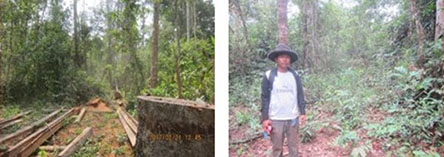Home > International Partnerships > Collaborative Research > Relationship between the Soil Degradation Pattern and Vegetation Recovery in Tropical Forests under Illegal Selective Cutting
Update:May 1, 2025
Main content starts here.
Relationship between the Soil Degradation Pattern and Vegetation Recovery in Tropical Forests under Illegal Selective Cutting

1. Partners
Institute of Forest and Wildlife Research and Development, Cambodia
2. Research Period
FY 2018-2022 Grant-in-Aid for Scientific Research (KAKENHI)
3. Lead Researcher
ITO, Eriko
4. Background
Expectations are increasing around the utilization of ecosystem functions in tropical forests to mitigate climate change, such as by fixing carbon dioxide and reducing emissions. Reliable vegetation recovery at selective logging sites is extremely important for the sustainable use of tropical forests. However, forest degradation as a result of the illegal selective logging of big trees for timber use is a problem in the evergreen forests of Cambodia, where deforestation continues to progress. Therefore, it is necessary to establish vegetation restoration methods that incorporate conditions that are specific to illegal logging.
5. Research Goal
Illegal selective logging for timber results in the felled trees being sawn on the spot because they have been procured through illegal activities. Consequently, a large amount of sawdust is supplied to the place where the trunk of the tree fell, while a lot of fresh leaves and vines are supplied to the place where the crown of the tree fell and is left as is. The aim of this research is to examine how these different conditions for supplying organic matter, which are unique to illegal logging, are related to vegetation restoration through the acceleration or mitigation of soil degradation.
6. Research Strategy
We are conducting soil surveys, leaf litter decomposition tests, and vegetation restoration surveys at selected logging sites in the forest reserve in Kampong Thom Province, Cambodia, all of which experienced illegal logging of large-diameter trees 10 years ago. We intend to examine how qualitative and quantitative differences in the organic matter that is redistributed to the forest floor during selective cutting affect the subsequent surface soil physicochemical properties and the decomposition of soil organic matter on the forest floor.
7. Scientific Achievement
A study was conducted to clarify the relationship between forest floor disturbance and forest regeneration after illegal selective logging in an evergreen forest area in Kompong Thom Province, Cambodia. The results of field surveys and soil analysis indicated that forest floor cover and post-logging vegetation recovery are important to prevent soil degradation. The large amount of sawdust supplied to the forest floor at the time of logging disappeared early, so it did not continue to protect the forest floor surface. Soil degradation and damage to the juvenile trees suggested that the potential for the forest to recover to its previous condition after selective logging was not great.
8. Applications
Spatial patterns of forest floor disturbance associated with illegal selective logging in Cambodian evergreen forests have been identified. This study showed that the survival of pre-existing juvenile trees on the forest floor at the time of logging is a key factor for vegetation recovery. This is an important finding for the conservation and restoration of forests in this region, which is undergoing rapid forest development.
9. Publications
Eriko ITO, Bora TITH (2023) Litter loss in Cambodian evergreen forests is mainly caused by soil macrofauna feeding. Cambodian Journal of Natural History, 2023(1), 1-7.
Eriko ITO, Naoyuki FURUYA, Yasuhiro OHNUKI, Mitsue SHIBATA, Mamoru KANZAKI, Yukako MONDA, Yoshimi SAKAI, Jumpei TORIYAMA, Takanobu YAGI, Bora TITH, Samkol KETH, Borin TO, Nang KETH, Chandararity LY, Phallaphearaoth OP, Sophal CHANN, Yoshiyuki KIYONO (2023) Spatially heterogeneous natural regeneration of tall evergreen dipterocarps, a target of selective logging. Cambodian Journal of Natural History, 2023(1), 62-71.
Eriko ITO, Naoyuki FURUYA, Yasuhiro OHNUKI, Bora TITH, Samkol KETH (2023) Selective cutting of large-diameter trees in a lowland evergreen forest in central Cambodia. Cambodian Journal of Natural History, 2023(1), 21-33.
Eriko ITO, Bora TITH, Borin TO, Junko NAGAKURA (2024) Physicochemical soil properties following selective cutting of large-diameter trees in a lowland dry evergreen forest in Cambodia. JARQ, 58(4), 215-232.
Copyright © Forest Research and Management Organization. All rights reserved.
